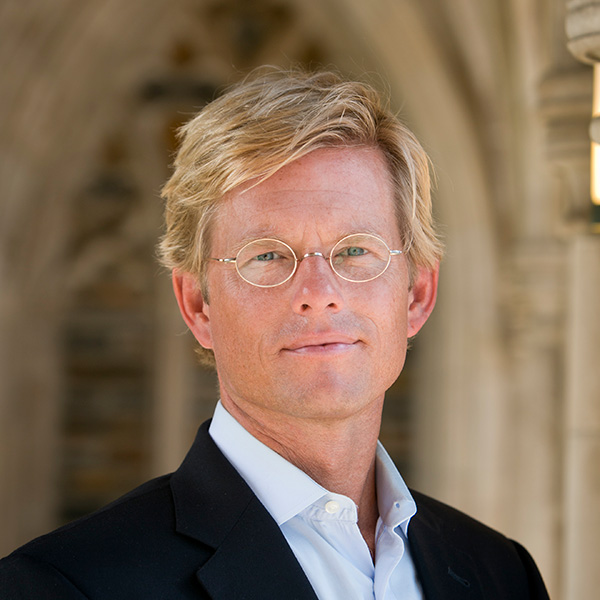The phrase “Christ-shaped leadership” should appeal to any Christian leader. What else are we supposed to be doing as Christians if not leading in the pattern of Christ?
The trouble is that Christ-shaped leadership has been used too many times to name various techniques or spiritual attitudes -- a discrete set of things to do or to feel that will enable the leader to lead Christianly. It is true, of course, that certain practices help develop Christ-shaped leaders.
But at its deepest level, becoming a Christ-shaped leader is about cultivating the right kind of background.
Psychologist William James famously described the world around us as a “blooming, buzzing confusion.” A second’s thought about the virtually inexhaustible and overwhelming movement of life around us at any given moment will show the aptness of James’ description, at least as this vast complexity appears to the human mind.
We cannot even begin to comprehend all that goes on around us in even a five-minute span -- the movement of molecules, the circulation of the blood, the bugs crawling, the wind currents shifting, the traffic noises, the sounds of animals or of conversation, and so forth.
Surprisingly, however, we don’t regularly experience the blooming and buzzing as blooming and buzzing. Indeed, apart from conscious reflection upon the teeming mob of stuff around us, we almost never notice it. Why?
The simple answer is that we have developed strategies that help to organize our lives by means of focused patterns.
These patterns are “sense makers”: they reduce the appearance of complexity by screening out certain things and highlighting others, and they make the world appear to us in specific and manageable ways -- ways that make sense of the buzzing. Most often, these patterns are not “seeable” in the foreground of our lives. Instead, they form the background.
The background is what enables us simply to take for granted that we need to do X rather than Y -- in this country, vote in elections, for example, to decide on the head of state rather than stage a military coup.
The reason voting makes sense is that we are shaped by a rich background of democratic concepts and practices that allow us to take for granted that voting is what we do to transfer power at the highest level. Switch the background against which voting makes sense, and the practice of voting every four years might look rather crazy.
As Barry Schwartz and Kenneth Sharpe point out in their book “Practical Wisdom: The Right Way to Do the Right Thing,” when we see a stop sign we don’t consciously think, “Hmm, what color? ... I know! I know! That’s red! What shape? Ah, octagon! Oh, yes, yes indeed, that’s the thing called a stop sign.” We just know it’s a stop sign.
How do we know? Not, for those who remember the Platonists, because there’s an eternal form of a stop sign in which this particular sign participates or to which it corresponds; nor, for those who remember the Cartesians, because “stop sign” is somehow an innate idea that comes with all human minds at birth.
To the contrary, we know it’s a stop sign because of the background that makes the red octagon “make sense” to us as a stop sign. In this case, the background is formed by the way the conviction about the importance of human life gets articulated through the dense network we call basic traffic safety: the road rules, symbols, habits of driving and educational practices that make possible the virtually instantaneous recognition of a stop sign as a stop sign.
As these two examples show, the importance of the background is quite remarkable: it structures how the world will appear to us and therefore how we will act in it. Our perceptions and practices make sense to us because they occur against a background that provides the sense they make.
Christ-shaped leadership is about developing a fundamentally Christian background in your institution or organization.
The point is to extend, deepen or, in some cases, begin to provide the sort of structure -- both interpretive and concrete -- so that Christian thought and practice are done by habit, as second nature. They are what “make sense” to do in your institution.
What “makes sense,” however, is not always easy or straightforward.
Indeed, on any account, the most arresting fact about developing Christ-shaped leadership is realizing that Jesus himself was actually killed. By all normal appearances, that is, his life’s work did not end in the triumphant establishment of God’s reign but in a shameful death and a scattering of his most committed workers.
In short, from the point of view of his death, Jesus’ whole ministry was a failure. Of course, Christians know the rest of the story -- how God raised Jesus from the dead and reversed the verdict upon his life. The resurrection validated Jesus’ ministry and drew together those who had deserted him in a new mission.
But the resurrection did not erase Jesus’ death, as if it could be removed from memory. Instead, the resurrection incorporated Jesus’ death into what became the distinctively Christian logic: Jesus was dead, but he is risen. This logic then formed the initial background of the new world the disciples learned to inhabit.
But the early Christians quickly learned that they had to say more than just the truth about Jesus’ resurrection; they needed to fill in the background that would form the conceptual and practical structure of the new movement.
The Christians, that is, needed to talk about things that flowed from the truth of Jesus’ death and resurrection but weren’t simply repetitions of this central fact.
For example, they had to figure out what to preach, what his ministry and resurrection meant for their reading of the Old Testament (which was, of course, the only Scripture they had in the earliest period), how to configure the community that was focused around belief in Jesus’ resurrection, how to handle persecution, and so forth.
Their overall attempt was to form the background of Christian thought and practice so that the things the early followers of Jesus ought to think and do as Christians would become second nature.
The New Testament shows the early Christians hard at work in developing a Christian background.
Paul, for example, regularly fought to establish several things that subsequent generations simply presupposed: that we do not earn our way to salvation by deeds of merit, that circumcision is not necessary for Gentiles to complete their salvation, that Jew and Gentile are fundamentally equal before God in terms of both their sin and their reception of God’s justifying grace.
The author of 1 John had to make sure that his churches knew that it was crucial to believe in the flesh of Jesus. The author of 1 Peter taught how to endure persecution and that suffering and dying for Jesus was better than cursing his name (apostatizing).
The Acts of the Apostles as a whole, in fact, is a chronicle of how the early Christians formed and reformed the background that constituted the habits of their life together. Chapters 2:37-47, 4:32-35 and the whole of 15 are what we might call nutshell versions of how the early Christians sought to create the background of Christian life. These passages concisely illustrate the interweaving of Christian doctrine, particular practices of the church and regular communal fellowship that forms a foundational pattern for Christian identity.
This pattern does nothing less than shape the intellectual and practical conditions under which Christian life will take place henceforth.
Long after the events of Acts, the church simply takes for granted what the early Christian leaders established: that to be Christian is to believe something quite specific about the significance of the death of Jesus of Nazareth (i.e., to “give testimony to the resurrection of the Lord Jesus,” as in Acts 4:33), to come together with one another “in the temple,” “break bread” and “distribute to each as any had need” (Acts 2:42, 46; 4:35), and to welcome others into the fold (Acts 15:8-9, 14).
Most of our arguments in the church today, in fact, are not about whether we should or should not abandon these things but about the specifics of their recognized and enduring force: What exactly do we need to believe about Jesus to be Christians? Can we celebrate communion together if we disagree over the meaning of the breaking of bread? What does welcoming the outsider look like?
Even our arguments, that is, take place against a common background that makes the arguments themselves meaningful and worth having. Once, this was not so; this background of our life as church actually had to be created for us to assume its presence and its terms within which our debates occur.
The power of the background to shape things Christianly cannot be overestimated.
It would be hard, for example, to imagine anyone today who seriously thought that Christians, to be Christians, did not need to believe anything in particular about Jesus of Nazareth, or have some sort of community life that included some version of the Eucharist, or practice hospitality in at least some way.
What the Apostles established is now taken for granted far and wide. Christian existence has a pattern and a structure that gives it a broadly consistent shape through time and across geographical space.
Moreover -- and simply put -- having a Christian background makes it easier to think and behave in ways that are Christian and harder to think and behave in ways that aren’t. Against the right kind of background, thinking about how to welcome the outsider, for example, will appear as natural as wondering how to hold a youth car wash or pay the light bill or turn a profit.
Conversely, when we act in ways that contravene the faith -- systematic lying or repeated deception, say -- those around us will experience, whether consciously or not, a dissonance with the overall pattern in which we work. “What?!? That doesn’t make any sense” will become a natural reaction to things that contradict or undermine the Christian background that structures an institutional or ecclesial culture.
Of course, in reality we work with multiple backgrounds, and even multiple layers of these various backgrounds, which are all simultaneously superimposed on one another. We never start from scratch but always work within an inherited background of one kind or another.
Discerning what is healthy in our inherited background and what needs to be pruned away is the work of traditioned innovation: we are always and simultaneously both receiving and creating the background against which we work.
This complexity makes the creation of Christian patterns of interpretation and practice difficult, and a work that requires great time and patience. Still, it is a profound illusion to think that Christians could exercise their institutional vocation apart from a background that structures their lives accordingly.
The choice between whether or not we have a background that makes sense of our lives is a false choice; we just do and will always have sense-making backgrounds.
The crucial question, therefore, is what kind of background provides the salient features needed to develop or extend Christian institutional patterns so that our work is organized Christianly as a matter of habit.
This sort of background needs to be both deeper and richer than the democratic theory and practice that underwrites voting, and at least equally mundane as stopping at a stop sign. This means Christian leaders will have to learn how to think about the interconnections between Scripture, tradition and contemporary life both creatively and hard.
Though the six features of thriving communities in Acts, for example, should guide a leader’s imagination, there are no prefabricated formulas that will lead in every time and in every case to a distinctively Christian form of institutional life. It will vary just as leaders and their institutions themselves do.
Yet there are some basic things to which we ought to pay attention, and over the next several months we will consider some of the more important features of a Christianly shaped background as we seek to understand Christ-shaped leadership.

















